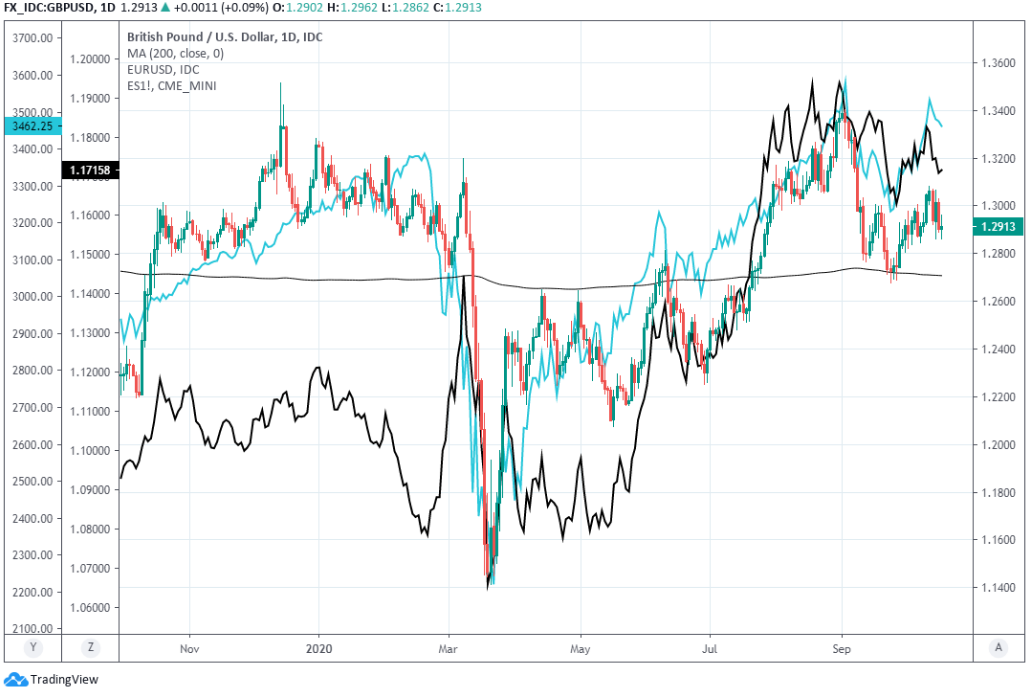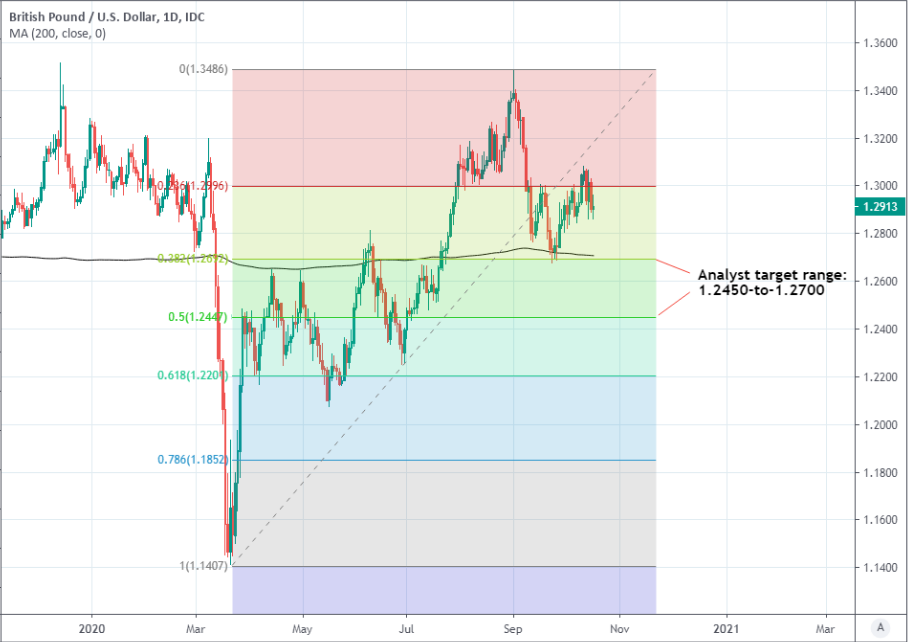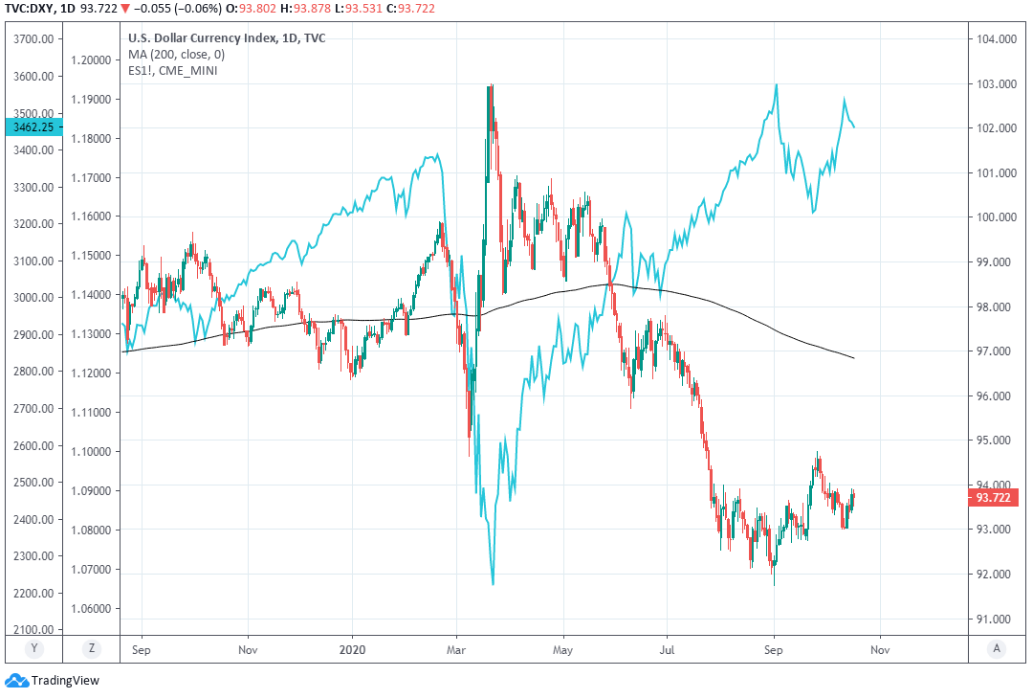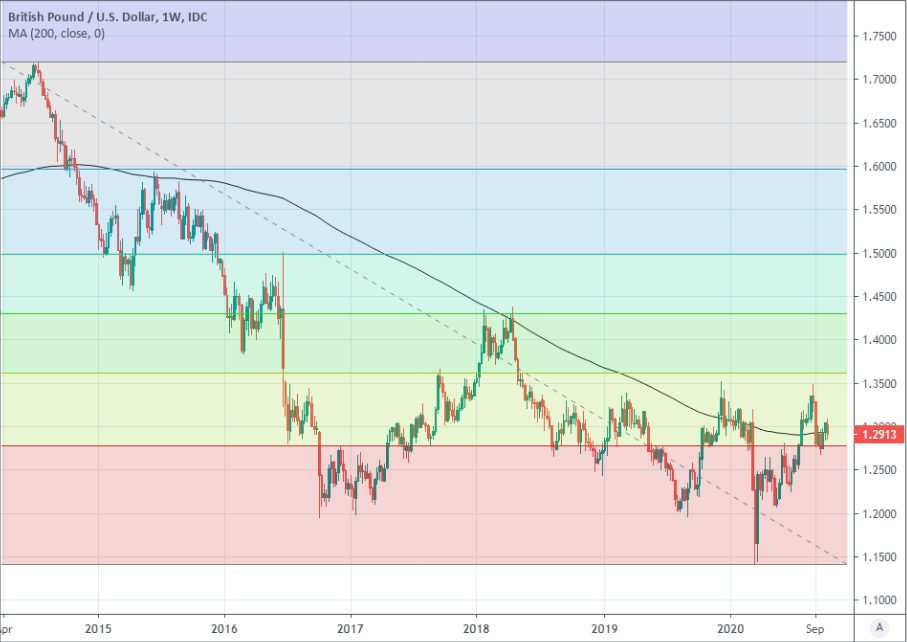Pound-to-Dollar Week Ahead Forecast: "Maintain a Negative Bias" says Commerzbank's Jones
- Written by: James Skinner
-
-Hope and cynicism all that keeps GBP/USD above May's lows.
-After Johnson questions merit talks and sentiment turns bearish.
-Underperformance looms but USD appetite also key to direction.
-MUFG sells GBP/USD as charts warn of fall back to at least 1.25.
Image © Adobe Images
- GBP/USD spot rate at time of writing: 1.2930
- Bank transfer rate (indicative guide): 1.2564-1.2654
- FX specialist providers (indicative guide): 1.2722-1.2800
- More information on FX specialist rates here
The Pound-to-Dollar rate could be set to underperform as the prospect of a 'no deal' outcome to Brexit trade negotiations prompts investor caution towards Sterling, and absent a clear end of efforts to reach a trade agreement Sterling may take its lead more from appetite for the Dollar and risk assets than it does the Brexit drama.
A Friday statements from UK Prime Minister Boris Johnson suggested that trade talks between the UK and EU have reached the end of the road, however the door to further talks was left over on the provision that the EU made a substantive shift in their position.
"Market participants are viewing the developments as mainly political posturing and still expect a last minute deal to be reached. But there is a higher risk that those expectations will be tested more seriously in the coming weeks which will open up more downside," says Derek Halpenny, head of research, global markets EMEA and international securities at MUFG. "We are recommending a short tactical GBP/USD trade idea to reflect higher Brexit risks."
The EU's Chief Brexit negotiator Michel Barnier is expected in London to hold talks with his opposite number, David Frost, early this week.
The Pound-to-Dollar exchange rate closed Friday with a mere 0.01% intraday gain that left it quoted at 1.2903, even after Prime Minister Johnson said that preparations for a trade relationship "more like Australia’s" are to be ramped up suggesting the market has been reluctant to take the latest threat seriously.
"The UK will need to acquiesce to a state aid regime that does not offer Downing Street unfettered autonomy. For its part, the EU will need to settle for more restricted access to fishing stocks than permitted under the status quo. A deal will also require the successful execution of a delicate piece of political choreography," says Adrian Paul, a Europe economist at Goldman Sachs.
Above: Pound-to-Dollar rate with Fibonacci retracements of March recovery and 200-day moving-average in black.
“The European Parliament is unlikely to ratify a free trade agreement as long as the most contentious clauses of the Internal Market Bill stand on the cusp of UK legislation. By the same token, the UK government is unlikely to drop the Internal Market Bill as long as it chafes at the stringency of the level playing field provisions embedded within the free trade agreement. We think the perceived probability of “no deal” will persist through the course of October. But our core view remains that a “thin” zero-tariff/zero-quota trade agreement will likely be struck by early November," Goldman's Paul says in a md-week research note.
Sterling was still down 0.79% for the week and analyst sentiment toward the British currency has turned decidedly bearish in recent days.
"While capped by 1.3085/1.3110 we will maintain a negative bias and continue to look for a slide to 1.2445 and then 1.2250/00. The recent high at 1.3083 is indicated to be the end of a wave 4 and the next move should be on the downside. Only above the 1.3083/1.3110 level would somewhat neutralise our outlook,” saus Karen Jones, head of technical analysis for currencies, commodities and bonds at Commerzbank.
Jones is a seller of GBP/USD from 1.3050 and is looking for a move down to at least 1.2450 in the coming weeks. Meanwhile, others including the team at Scotiabank are also warning of a similar outcome, although they see losses taking the Pound only as far as the “1.24/1.25 range.”
“On the one hand, the GBP has pushed above the ceiling of the Aug/Sep consolidation (potential bull flag). On the other, the September GBP-bearish monthly reversal remains intact, the bearish MA crossover supports the loss of upside momentum and GBP-supportive trend signals on the longer run oscillators have flattened out completely while intraday signals are turning bearish,” says Juan Manuel Herrera, a strategist at Scotiabank.
The charts are clear cut in having turned bearish but fundamentally, the problem is that the outlook for Sterling is clouded by the fact that if a Brexit trade deal was to be reached it would require compromises from both sides.
This, for the sake of domestic audiences on each side, might necessitate something like a political pantomime to play out first over the coming weeks before anything can actually be announced.
Above: Pound-to-Dollar rate alongside S&P 500 index (blue line, left axis) and EUR/USD (black line, left axis).
“The currency decline was relatively muted considering that no risk premium (associated to no deal Brexit) has been priced into the currency for some time. If the market credibly believed in the threat of a no deal Brexit (as expressed today), GBP would be materially weaker today, in our view," says Petr Krpata, chief EMEA strategist for currencies and bonds at ING. "We expect the UK-EU trade negotiations to continue next week, suggesting a limited downside to GBP, with GBP/USD to be primely driven by EUR/USD.”
It’s the above widespread notion more than anything else that may have spared the Pound-to-Dollar rate from any meaningful or sustained punishment on Friday and which could yet constrain the degree to which it falls for as long as contact between the two sides continues.
This could mean the Pound-to-Dollar rate has scope rise and fall with other major exchange rates over the coming days, even if it does lag those exchange rates - which would lead at least to range-bound trading against other major currencies if-not outright declines.
“We do not expect the next leg lower in USD to come until after the stimulus is passed and as positions are rebalanced,” says Bipan Rai, North American head of FX strategy at CIBC Capital Markets. “Biden’s lead has narrowed a bit over the past week in a few key states, but still remains quite large.”
If the Pound is to continue taking direction from global factors then appetite for the Dollar, the trajectory of the S&P 500 and Chinese GDP data due out in the early hours of Monday morning will all be important influences. So too will U.S. election opinion polls following this Wednesday's debate between President Donald Trump and Democratic Party presidential candidate Joe Biden.
Pound Sterling is one of the most sensitive among major currencies to movements in the Chinese Yuan, which could rise early in the new week if the economist consensus is either right or underestimating the likely third quarter performance of the Chinese economy.
Consensus looks for GDP growth to have risen from an annualised 3.2% in the second quarter, to 5.5% for last quarter. The data is out at 03:00 Monday. Any disappointment in China would be a burden for Sterling.
Above: Dollar Index shown at daily intervals alongside S&P 500 index futures (blue line, left axis).
"While the first half of 2020 saw sharp declines in Chinese imports (with China the first country to be hit by the pandemic), things have started to look up for German, French and Italian exports to China in recent months and especially in September. China’s imports from UK, however, have still not registered positive growth, even though they continue to improve," says Giovanni Zanni, chief Euro area economist at Natwest Markets.
At the same time, coronavirus containment in Europe, where a second wave has led governments to impose tightened restrictions on continental capitals and other parts of major European economies, may also be important driver of sentiment and price action too.
A part of this year’s rally in the Euro-to-Dollar rate and closely correlated currencies like Sterling has resulted from perceptions that Europe is poised to outperform the U.S. economy but the mounting prospect of the old continent being clobbered with some form of winter ‘lockdown’ has already undermined this outlook and could yet turn into a source of upside for a reviled U.S. Dollar that was sold almost relentlessly through the summer months.
“The surge in new COVID cases in the UK is increasing downside risks for the GBP by applying more pressure on the government to tighten restrictions. The outlook for the UK economy is darkening heading into year end which could encourage the BoE to deliver more stimulus,” MUFG’s Halpenny says. “The US dollar is on shaky foundations. Near-term risks are limiting appetite for USD selling now, but that will change, possibly once we are beyond the US election."
New restrictions imposed through late September and early October may mean the economist consensus is radically underestimating the size of the likely falls in October’s flash IHS Markit PMI surveys this week and that investors may no longer be able to take so lightly the ongoing talk from the Bank of England about the prospect of a shift to negative interest rates.
IHS Markit PMI surveys are set for release at 09:30 Friday, when the all-important services PMI is expected to fall from 56.1 to 53.4, which would still leave it at a level that implies some form of growth in the sector. But before then BoE Governor Bailey will speak at 10:25 on Thursday in an address to the Waterline Summit. Both events could draw increased scrutiny from the market given dual Brexit and coronavirus challenges.
Above: Pound-to-Dollar rate with Fibonacci retracements of 2015 downtrend and 200-week moving-average in black.






